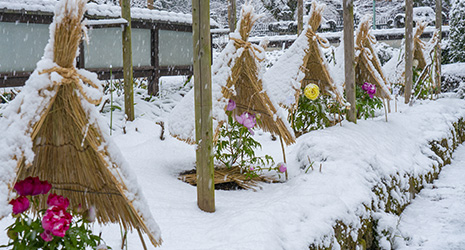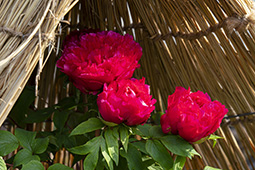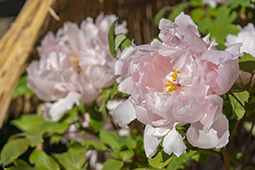February 2023
- English
- 日本語
A Garden of Winter Peonies

Peonies and their protective warabotchi under a light fall of snow 
Peonies and their protective warabotchi

Red winter peonies under their protective warabotchi covering 
Pink winter peonies

Peonies are normally considered a spring flower, but their flowering time can also be adjusted to winter, from January to late February. In Taito City, northeastern Tokyo, a spectacular display of “winter peonies” can be enjoyed at the Ueno Toshogu Peony Garden.

Peonies are deciduous shrubs native to northwestern China which were brought to Japan around 1,300 years ago. The peony was considered the “King of Flowers” in Tang Dynasty China because of the unusually large (10 to 30 cm) and fragrant flowers that bloom from the small bush. The plant was originally cultivated for its root bark which was used in medicine, but about 500 years ago peonies became popular as ornamental garden plants in Japan, and in recent years, numerous varieties have been developed through selective breeding to produce flowers of many different shapes and colors.
“The standard varieties of peonies are called ‘spring peonies’ and they bloom from April to May. There are also varieties that also bloom in early winter, which are known as ‘cold peonies,’” says Ono Shingo, director of the Ueno Toshogu Peony Garden.

“However, these cold peonies are easily affected by weather and each bush produces only a few small flowers. To make up for these shortcomings, ‘winter peonies’ have been developed to bloom early in the year,” says Ono. To achieve this, varieties of peonies that bloom in the spring are kept in a dormant state at low temperatures to delay their normal blooming period by around eight months. The flowers produced are large and elegant just like spring peonies. Using this bloom-delay technique, it is possible to enjoy vivid flowers in winter, a season with the fewest natural flowers.
Ueno Toshogu, located in present-day Ueno Park in Taito City, northeastern Tokyo, was built in 1627 and enshrines Tokugawa Ieyasu (1542–1616), the first shogun of the Tokugawa Shogunate (1603–1867). The Peony Garden is a Japanese kaiyu-style garden (circuit-style garden) built in a corner of the shrine grounds. It opened in 1980 as a symbol of friendly relations between Japan and China. The garden is busy with visitors during the Spring Peony Festival from early April through early May as well as from January 1 through to late February when the winter peonies are in bloom. Since 2020 the garden has put in place countermeasures to prevent the spread of the new coronavirus. During this Winter Peony Festival, which is being held for the 41st time in 2023, 160 plants of 40 varieties, mostly from Japan and China, are on display.

“When peonies are exposed to the cold, their leaves become damaged, so we cover the bushes with protective warabotchi structures that we make from straw. We have to cover the plants completely when there is cold rain, wind, or when the temperature drops, so we have to pay attention to the weather forecast during this season,” says Ono.
According to Ono, while winter peonies require such careful attention, the flowers bloom for up to a month thanks to the low temperatures. Spring peony flowers by contrast bloom all at once as temperatures quickly rise during the blooming season, and the petals fall off quickly in around five days. It rarely snows in Tokyo during the winter peony season, so when it does and the snow piles up, the spectacle of large, colorful flowers of red, pink, white, and yellow blooming beneath snow-covered warabotchi is particularly enchanting.
From early in the new year, when the winter peonies are in bloom, wintersweet and early-blooming plum trees can also be enjoyed in the garden. By February, with the peonies still in bloom, the weeping plum trees, early-blooming cherry trees and forked-stem adonis are also coming into flower. Though it is still bitterly cold, the colorful atmosphere of the garden grows little by little as spring approaches, and it is a pleasure to see the changes that add yet more color to the flowers of the winter peonies.

